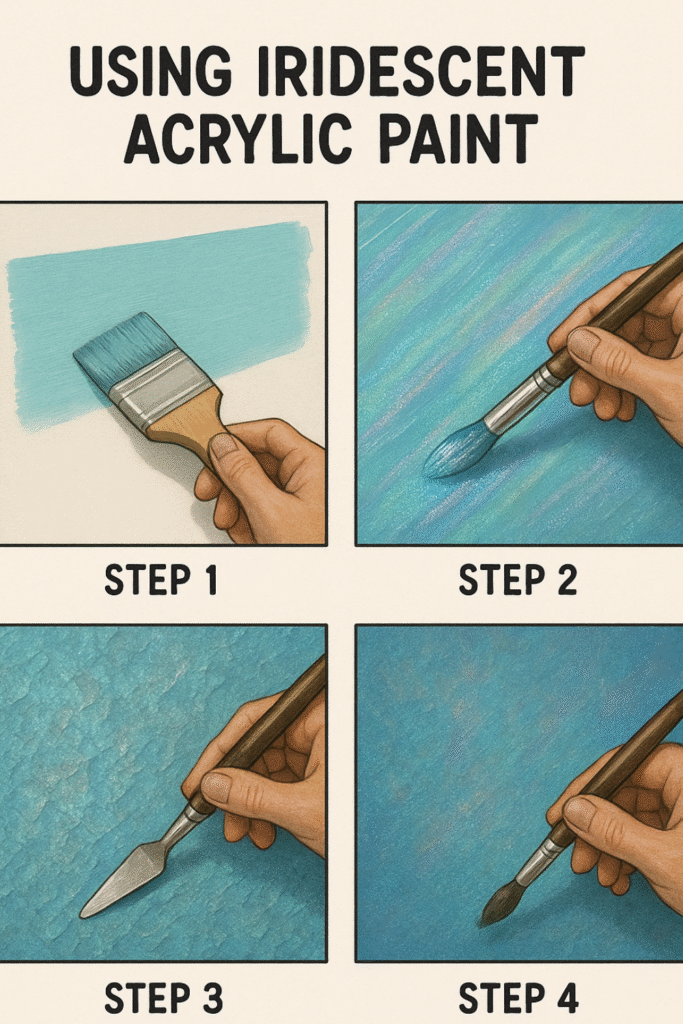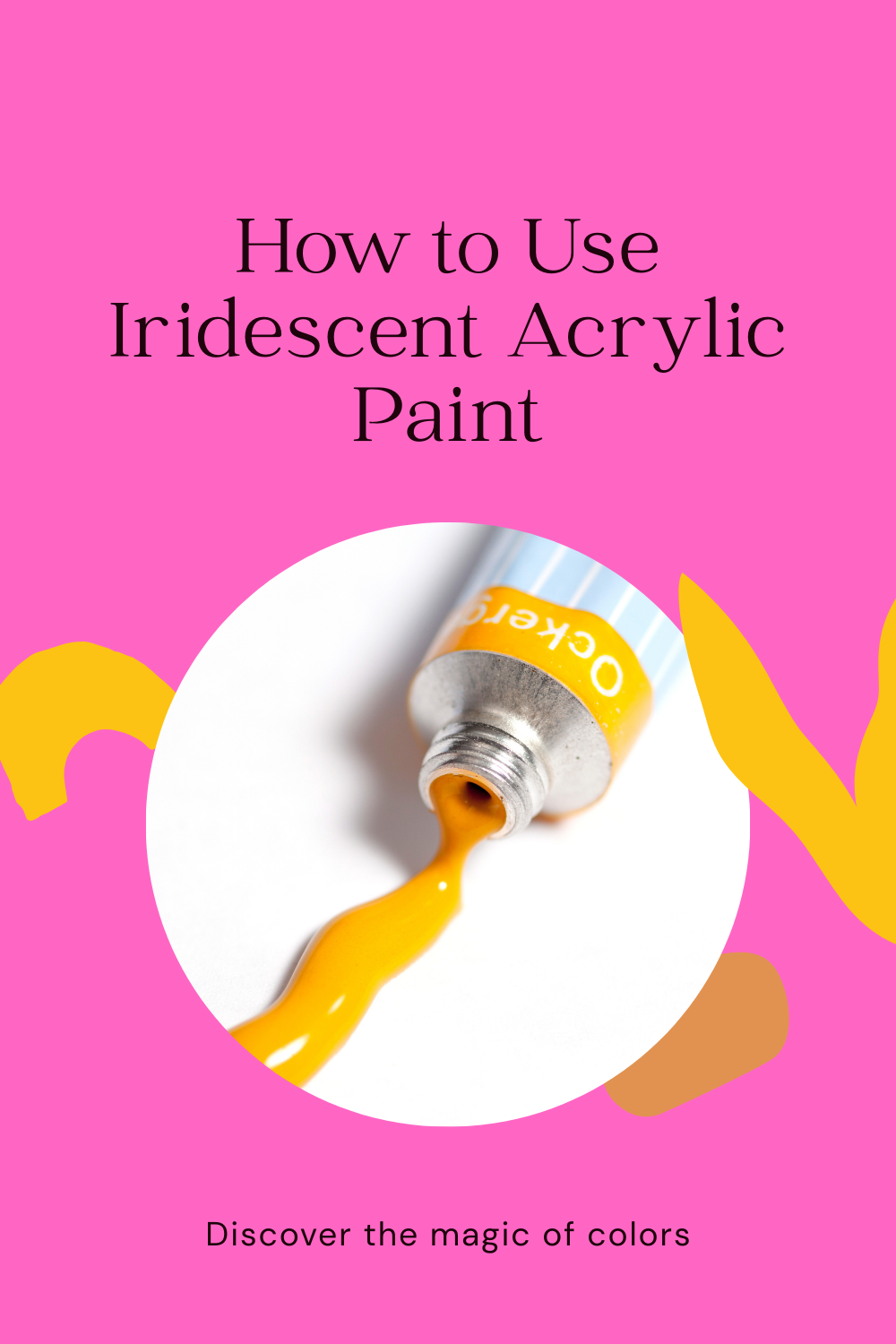Acrylic paints are a staple in every artist’s toolbox, but have you ever tried iridescent acrylic paint? Whether you’re a seasoned artist or a beginner looking to add some sparkle to your work, iridescent acrylic paints can elevate your art to a whole new level.
They provide a mesmerizing, shimmering effect that changes depending on the angle of the light, adding depth and intrigue to any painting.
If you’re curious about how to make the most out of these dazzling paints, you’re in the right place.
In this guide, I’ll take you through everything you need to know about iridescent acrylic paint how to use it, tips and tricks, and common mistakes to avoid. By the end of this article, you’ll be equipped with all the knowledge you need to create stunning, luminous artworks!
What is Iridescent Acrylic Paint?
Before we dive into the nitty-gritty of using iridescent acrylic paint, let’s first understand what it actually is. Iridescent paints have a special quality that makes them shine and change color depending on the light and angle from which they are viewed.
They differ from regular acrylic paints in that they contain fine, shiny particles that catch and reflect light in a way that creates a shimmering effect.
These paints can range from subtle, pearlescent hues to bold, metallic finishes. You can find iridescent acrylic paints in various colors, each with its own unique shimmer effect, and they are often used to add highlights, texture, or dimensionality to a piece.

Why Use Iridescent Acrylic Paint?
You might be asking, “Why should I choose iridescent acrylic paint over regular acrylics?” The answer is simple: to bring a new layer of visual interest and depth to your artwork. Iridescent paints create a dynamic, ever-changing look that can’t be achieved with standard colors. This makes them perfect for creating:
- Shimmers and Highlights: Use them to highlight specific areas in your artwork, making those sections pop with light.
- Textures and Layers: They add texture and complexity, especially when applied on top of other paints or mediums.
- Metallic Effects: For a more modern, futuristic, or fantasy vibe, iridescent paints provide the perfect metallic sheen.
- Unique Color Shifts: The shifting colors provide an extra dimension, as they can look one way from one angle and completely different from another.
How to Use Iridescent Acrylic Paint
Now, let’s move on to how you can use iridescent acrylic paint in your art. Whether you’re using it for a subtle effect or making it the star of your composition, there are various ways to incorporate it into your projects.
Preparation Before You Start
Before you start painting, there are a few important things to keep in mind:
- Surface Selection: Iridescent acrylic paint works beautifully on various surfaces, but make sure your surface is clean and dry. Common surfaces include canvas, wood, or even plastic, but you’ll get the best results on primed or prepared surfaces.
- Mixing with Other Acrylic Paints: Iridescent acrylic paints can be mixed with regular acrylics to create custom colors with that extra shimmer. Just make sure to mix thoroughly to prevent uneven application.
- Materials You’ll Need: Here’s a list of things you’ll need before you begin:
- Iridescent acrylic paint (in the colors of your choice)
- Paintbrushes (preferably with soft bristles for smooth application)
- A palette for mixing
- A clean surface (canvas, wood, etc.)
- A palette knife (optional, for adding texture)
Step-by-Step Guide for Using Iridescent Acrylic Paint
Step 1: Applying the Base Layer
Start by applying your base layer of acrylic paint. Iridescent paints work best when they are applied over a flat, solid color background. If you want to create a smooth, uniform shimmer, make sure the surface is covered with a solid base color that complements the iridescent finish.
- Tip: You can use a contrasting color for the base layer to make the iridescent paint stand out more.
Step 2: Applying Iridescent Acrylic Paint
Using a clean, soft brush, apply the iridescent acrylic paint over the base layer. The beauty of iridescent paint lies in its ability to catch the light, so make sure to use even strokes. You can apply it thickly for a bold, metallic look or thinly for a more subtle shimmer.
- Tip: For an even shimmer effect, apply thin layers of paint and let them dry in between applications. This way, you can gradually build up the intensity of the shimmer without overwhelming your base layer.
Step 3: Create Texture or Effects
If you’re looking to add texture or more intricate effects, use a palette knife or other tools to create depth. This is perfect for abstract works or for giving a landscape a more three-dimensional quality. You can also apply the iridescent paint in different directions to create varying effects depending on how the light hits it.
- Tip: Experiment with different tools like sponges, brushes, or even fingers to see what textures you can create.
Step 4: Let it Dry and Add Final Touches
Once you’ve applied the paint, allow it to dry completely. Acrylics dry quickly, but make sure not to rush it. Once dried, you can apply another layer if you want to intensify the shimmer or touch up areas that need more coverage.
Different Uses of Iridescent Acrylic Paint
| Use Case | Description | Best Techniques/Tools | Recommended Surface |
| Abstract Art | Add shimmering effects to abstract paintings. Mix with other colors for vibrant, shimmering compositions. | Use soft brushes and palette knives for texture. Layer thin coats. | Canvas, Wood, Paper |
| Portraits & Figures | Apply highlights to facial features or clothing for a glowing effect. | Use fine brushes for precision. Layer lightly to avoid overpowering. | Canvas, Paper |
| Landscapes (Water, Sky) | Highlight reflective surfaces like water or create a glowing sky effect. | Use a flat brush for smooth application. Build up layers. | Canvas, Wood |
| Decorative Pieces | Use on vases, frames, or furniture to add sparkle to everyday objects. | Apply with a sponge or brush, allow to dry between layers. | Wood, Ceramic, Metal |
| Mixed Media | Add texture or depth over collage, pastels, or markers. | Use a palette knife or sponge for texture. Can also mix with gels. | Canvas, Paper, Wood |
Creative Ways to Use Iridescent Acrylic Paint
1. Abstract Art: Iridescent paints shine in abstract pieces. Mix them with other colors to create vibrant, shimmering compositions. Layer the paints to add depth and dimension.
2. Portraits and Figures: Add iridescent highlights to your portraits, creating a glowing effect on skin tones, hair, or clothing.
3. Landscapes: Use iridescent paints to highlight elements in a landscape, like water, the sky, or any reflective surface. The shimmering effect can make your piece come to life, especially when the light changes.
4. Decorative Pieces: Iridescent acrylic paint is also perfect for DIY projects. Try using it on vases, frames, or furniture to give everyday items a touch of sparkle and elegance.
5. Mixed Media: If you’re working with mixed media, iridescent acrylics are great for adding an extra layer of texture and shine over collage elements, markers, or pastels.
Common Mistakes to Avoid
While iridescent acrylic paints are a lot of fun to use, there are a few common mistakes to watch out for:
- Using Too Much Paint: Iridescent paints can be overpowering if applied too heavily. A little goes a long way, so apply it in thin layers and build up the effect gradually.
- Not Allowing Paint to Dry: Acrylics dry quickly, but if you’re layering the iridescent paint over other colors, be sure to allow the base layer to dry first. This will help prevent blending or muddying the colors.
- Using the Wrong Brushes: For smoother, more even coverage, choose soft brushes. Stiff brushes can cause uneven application and streaking, which can ruin the shimmering effect.
- Not Considering the Light: Iridescent paints look different depending on the light. Make sure to step back and observe your painting from different angles to see how the light affects the iridescent effect.
- Overcomplicating the Design: While it’s tempting to go overboard with shimmering highlights, it’s best to use iridescent paints sparingly to maintain balance and harmony in your artwork.
Frequently Asked Questions (FAQs)
Q1: Can I mix iridescent acrylic paint with other mediums?
Yes, iridescent acrylics can be mixed with other acrylic paints, mediums like gels or pastes, and even water for different textures. Just make sure to test the mixture to ensure the shimmer effect is still present.
Q2: How do I clean brushes after using iridescent acrylic paint?
Iridescent acrylics can be a bit tricky to clean, so always wash your brushes with warm water immediately after use. If the paint has dried, use a brush cleaner or mild soap to get rid of any residue.
Q3: Is iridescent acrylic paint waterproof?
Once dry, iridescent acrylic paint is water-resistant, but it’s not fully waterproof. For extra protection, consider sealing your artwork with a clear acrylic varnish.
Q4: Can I use iridescent acrylics on fabric?
Yes, you can use iridescent acrylics on fabric, but make sure to heat-set the paint by ironing it on the reverse side of the fabric after it has dried to ensure the paint stays permanent.
Conclusion
Iridescent acrylic paints offer an exciting way to enhance your artwork with their shimmering, light-catching effects. Whether you use them to add subtle highlights, create bold metallic effects, or build up texture, they are a fantastic tool for any artist looking to bring their creations to life in a new, dynamic way.
The key to mastering iridescent acrylics is to practice patience and experiment with different techniques and tools. By applying it in thin layers and understanding the lighting effects, you’ll be able to create stunning works of art that truly stand out. So, grab your paints and get creative!




